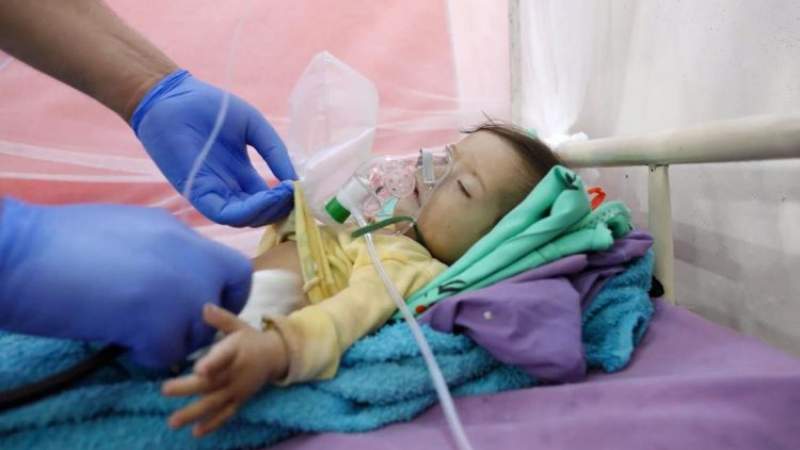CNN Reveals Famine has Arrived in Pockets of Yemen

Yemen: When 10-month-old Hassan Ali arrived at the hospital, doctors were hopeful they could save him. So many children in northern Yemen, after all, don't even get this far, starved not only of food but also the fuel needed just to reach medical help.
CNN watched overstretched doctors and nurses as they tried to give oxygen to Hassan, who had arrived six days earlier but wasn't putting on any weight, and was struggling to breathe. Just hours later, Hassan died.
"He is just one of many cases," said Dr. Osman Salah. The ward is full of children suffering from malnutrition, including babies just weeks old.
Every month, this hospital's pediatric ward takes in more patients than its capacity of 50, sometimes twice as many. Around 12 children die there each month, Salah said. He and his staff are running on empty -- they haven't been paid for more than half a year.
An estimated 47,000 people are likely to be living with "catastrophic" levels of food insecurity -- or famine-like conditions -- according to an analysis by the Integrated Food Security Phase Classification (IPC), the world's authority on food security. A further 16 million are living in either "crisis" or "emergency" food security conditions, the analysis shows. That's more than half of Yemen's population.
Pockets of Yemen have slipped into famine
At the end of 2020, some 16,500 people from five districts in northern Yemen had moved into the “catastrophe/famine” category — the most extreme level of food insecurity — according to the Integrated Food Security Phase Classification. The rapidly deteriorating situation is the result mostly of funding cuts that have battered activities by agencies like the World Food Programme, which is struggling now to meet the most basic of needs for millions of Yemenis, particularly in the country's north.
A bitter blockade
Fuel typically comes into the country's north via the port of Hodeidah, usually bustling with economic activity at the best of times. Even during Yemen's ongoing civil war, it has been a lively gateway for the conflict economy, where food and other aid that Yemenis rely on arrive.
CNN obtained documents from the port's arrival log showing that 14 vessels had been cleared by the UN's verification and inspection body to carry fuel to the country. The tracking website MarineTraffic.com shows those vessels are now sitting in the Red Sea between the Saudi-Yemen border and Eritrea, unable to unload their fuel.
"From March 2021, WHO will have to stop distributing fuel to 206 facilities across the country, over 60 percent are hospitals providing services not available at the already fragile primary level. This will lead to the stoppage of life-saving services, such as emergency rooms and intensive care units, including COVID-19 ICUs. Over 9 million people will be affected," it said in a document, shared with CNN.
Can Biden turn the war?
The dynamics of the conflict, however, appear to be rapidly changing. In February, US President Joe Biden announced a new Yemen strategy, giving momentum to the search for a ceasefire and eventual political solution.
The Obama administration was supportive of Saudi Arabia's intervention in Yemen in 2015 and offered the Kingdom arms deals worth more than $115 billion total, more than any other US administration in the history of US-Saudi relations, according to a report by the Center for International Policy.
As part of his new approach, Biden also appointed a special envoy for Yemen, Tim Lenderking, who is wrapping up a two-week visit to region, trying to engage different parties and give mediation efforts a reboot.
When asked about US support for Saudi Arabia while the country was blocking fuel deliveries to Hodeidah, Lenderking said the situation was "complex."
"Ultimately, until there's an end to the war, we are doing what we can to save lives. But Yemen needs peace," said the World Food Programme's Yemen spokesperson Annabel Symington.
Philippe Duamelle, the Yemen representative for UNICEF, is making an urgent plea for donors to step up their pledges, warning that 2.3 million children under the age of 5 in Yemen are projected to suffer acute malnutrition this year, up 16% from 2020.
"The children of Yemen cannot wait, we've got to be able to assist them and save them now. The situation has deteriorated significantly, and we need to reverse the trends now," he said.
But in all humanitarian disasters, there are glimmers of hope. In the district of Harf Soufian, which in January descended into the "catastrophic" famine-like category, another 10-month old baby, just like Hassan Ali, has been fighting for her life.
Zahra sat in her mother's arms, sucking her fingers, at the Rural Harf Soufian Hospital. All the staff here have been excited by her success story.
When she came to the hospital, her doctor said, she weighed just 5 kilograms, putting her in the bottom 5% for girls by weight, according to WHO growth standards. In just four days, she has put on 400 grams, no mean feat for a baby from a district starved of food.
Source: CNN
#Yemen #Famine #US-Saudi Aggression About 3 years
-
09:28
Khalil Al-Hayya: We have defeated the occupying entity, crushing its prestige and the power of its army
09:04
Khalil Al-Hayya: Resistance, people in Gaza shattered myth of Israeli invincibility
04:54
President Joseph Aoun: Lebanon is committed to the Israeli withdrawal on February 18 and rejects any delays under any pretext, as well as demands the return of Lebanese prisoners.
04:48
Gaza Health Ministry: Evacuation of wounded Palestinians through Rafah border crossing will begin on Saturday
11:38
Lebanese Civil Defense: 2 martyrs, 9 wounded in Israeli airstrikes on the Bekaa, eastern Lebanon, last night





